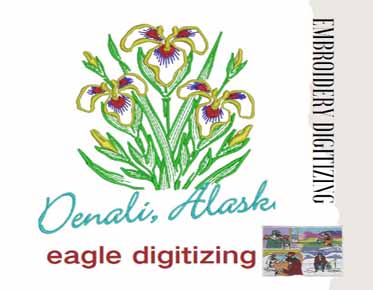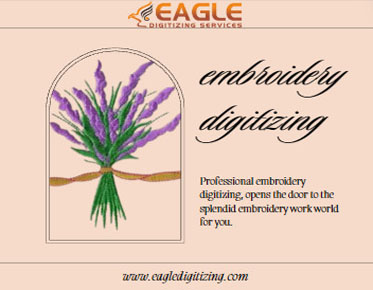Unleashing Creativity: Kids & Digital Art/Eagle Digitizing
In today's digitally driven world, education is undergoing a
transformation, and one of the key catalysts for this change is the integration
of digitized vector and graphic arts into learning materials for kids. From
vector illustrations to interactive graphic design elements, digital art offers
a myriad of opportunities to enhance children's learning experiences. In this
article, we'll delve into the various aspects of digitized art in education,
exploring its role, benefits, challenges, and future possibilities.
The Role of Digital Art in
Education
In the realm of education, digital art plays a pivotal role in
revolutionizing traditional teaching methods. By leveraging technology,
educators can create immersive and interactive learning experiences that resonate
with today's tech-savvy generation.
Importance of Visual Learning
for Kids
Visual learning is essential for children as it stimulates their imagination, enhances comprehension, and fosters creativity. Digitized vector and graphic arts provide a dynamic platform to cater to visual learners, making complex concepts more accessible and engaging.
Understanding
Digitized Vector Art
What is Vector Art?
Vector art is a form of digital illustration created using
mathematical equations rather than pixels. Unlike raster images, which lose
quality when scaled, vector graphics maintain their crispness and clarity,
making them ideal for educational materials.
Advantages of Vector Art in
Learning Materials
The advantages of vector art in learning materials are manifold. Not only does it allow for infinite scalability without loss of quality, but it also enables easy manipulation of elements, facilitating customization and adaptation to diverse learning styles.
Exploring
Graphic Arts for Kids
Introduction to Graphic Arts
Graphic arts encompass a wide range of visual mediums, including
typography, photography, and digital design. By introducing children to graphic
arts, educators can nurture their artistic skills and visual literacy from an
early age.
Benefits of Graphic Arts for
Children's Learning
Graphic arts offer numerous benefits for children's learning, including improved spatial reasoning, enhanced communication skills, and increased digital fluency. Through hands-on exploration and experimentation, kids can unleash their creativity and express themselves in new and exciting ways.
Incorporating
Digital Art in Educational Materials
Digital Art Tools for Kids
There is a plethora of digital art tools specifically designed for
children, ranging from user-friendly drawing apps to interactive design
platforms. These tools empower kids to unleash their creativity and bring their
ideas to life digitally.
Tips for Creating Engaging
Learning Materials with Digital Art
When creating learning materials with digital art, it's essential to prioritize engagement and interactivity. Incorporating gamification elements, interactive quizzes, and animated illustrations can captivate children's attention and make learning a fun and immersive experience.
Enhancing
Learning with Vector Illustrations
How Vector Illustrations Support
Learning
Vector illustrations serve as powerful visual aids that simplify
complex concepts, clarify information, and reinforce learning objectives. By
leveraging the versatility of vector graphics, educators can create dynamic
learning materials that cater to diverse learning styles.
Examples of Vector Illustrations
in Educational Materials
From colorful infographics to interactive diagrams, vector illustrations are ubiquitous in educational materials across various subjects. Whether it's explaining scientific principles or illustrating historical events, vector graphics enhance comprehension and retention for students of all ages.
Interactive
Learning with Graphic Design
Interactive Graphic Design
Elements
Interactive graphic design elements, such as clickable icons,
draggable objects, and animated charts, transform static content into dynamic
learning experiences. By encouraging active participation and exploration,
interactive design fosters deeper engagement and understanding among students.
Incorporating Interactivity in
Learning Materials
Integrating interactivity into learning materials requires thoughtful design and strategic implementation. By aligning interactive elements with learning objectives and leveraging feedback mechanisms, educators can create immersive experiences that promote active learning and knowledge retention.
Digital
Art for Multisensory Learning
Engaging Multiple Senses with
Digital Art
Multisensory learning leverages auditory, visual, and tactile stimuli
to enhance learning outcomes and cater to diverse learning preferences. Digital
art provides a versatile medium for incorporating multisensory elements into
educational materials, enriching the learning experience for children.
Using Digital Art to Enhance
Retention and Understanding
By integrating interactive animations, audiovisual presentations, and tactile simulations, educators can create immersive learning experiences that appeal to multiple senses and reinforce learning concepts. Digital art enhances retention and understanding by providing learners with interactive and memorable experiences.
Customizing
Learning Materials with Vector Graphics
Tailoring Vector Graphics to
Different Learning Styles
Every child learns differently, and vector graphics offer a flexible
canvas for tailoring learning materials to individual needs. Whether it's
providing visual scaffolding for visual learners or incorporating auditory cues
for auditory learners, vector graphics can be customized to accommodate diverse
learning styles.
Personalization and Adaptation
in Educational Design
Personalization is key to effective educational design, and vector graphics enable educators to adapt learning materials to the unique needs and preferences of each student. By incorporating personalized feedback, adaptive learning pathways, and customizable content, educators can optimize learning outcomes and foster student success.
Innovative
Approaches to Graphic Art in Education
Trends in Educational Graphic
Design
Educational graphic design is constantly evolving, driven by
technological advancements, pedagogical insights, and emerging trends. From
immersive virtual reality experiences to augmented reality textbooks, educators
are embracing innovative approaches to engage students and enhance learning
outcomes.
Experimentation and Creativity
in Educational Art
Creativity thrives on experimentation, and educational art is no exception. By encouraging educators to explore new tools, techniques, and mediums, educational institutions can foster a culture of creativity and innovation that inspires students to think critically, solve problems, and express themselves artistically.
Addressing
Challenges and Concerns
Potential Pitfalls of Digitized
Art in Education
While digitized art offers numerous benefits for education, it also
presents challenges and concerns that must be addressed. These include issues
related to accessibility, digital equity, privacy, and security, as well as the
potential for distraction and information overload.
Solutions and Best Practices for
Overcoming Challenges
To mitigate the challenges associated with digitized art in education, it's essential to adopt a holistic approach that prioritizes accessibility, inclusivity, and digital citizenship. By implementing best practices for designing, implementing, and evaluating digital learning materials, educators can create safe, engaging, and effective learning environments for all students.
Promoting
Creativity and Expression through Digital Art
Fostering Creativity in Children
through Digital Art
Digital art empowers children to unleash their creativity, experiment
with different artistic styles, and express themselves in new and exciting
ways. By providing opportunities for self-expression and creative exploration,
educators can nurture a lifelong passion for art and design in young learners.
Empowering Kids to Express
Themselves through Graphic Design
Graphic design is more than just creating pretty pictures; it's about communicating ideas, solving problems, and expressing emotions. By teaching kids the fundamentals of graphic design, educators can equip them with valuable skills that are essential for success in the digital age.
Integrating
Digital Art Across the Curriculum
Applications of Digital Art in
Various Subjects
Digital art has applications across a wide range of subjects,
including STEM, humanities, language arts, and social sciences. Whether it's
creating interactive simulations for science experiments, designing multimedia
presentations for history projects, or crafting digital stories for language
arts assignments, digital art enriches learning experiences and fosters
interdisciplinary connections.
Cross-Curricular Learning
Opportunities with Digital Art
By integrating digital art across the curriculum, educators can create meaningful learning experiences that transcend traditional disciplinary boundaries. Collaborative projects, interdisciplinary units, and cross-curricular initiatives provide students with opportunities to apply their knowledge and skills in real-world contexts, fostering critical thinking, creativity, and collaboration.
Ensuring
Accessibility and Inclusivity
Making Digital Art Accessible to
All Learners
Accessibility is paramount in educational settings, and digital art
should be inclusive and accessible to learners of all abilities. This includes
providing alternative formats for students with disabilities, ensuring
compatibility with assistive technologies, and adhering to accessibility
standards and guidelines.
Strategies for Inclusive Design
in Educational Materials
Inclusive design involves considering the diverse needs and preferences of all learners throughout the design process. This includes designing with empathy, conducting usability testing with diverse user groups, and incorporating feedback from stakeholders to ensure that educational materials are accessible, usable, and effective for everyone.
Harnessing
the Power of Visual Storytelling
Storytelling through Digital Art
Visual storytelling is a powerful educational tool that engages
students, conveys complex ideas, and fosters emotional connections. By
combining imagery, text, and multimedia elements, educators can create
compelling narratives that captivate learners' imaginations and deepen their
understanding of various concepts and themes.
Enhancing Narrative
Understanding with Visual Elements
Visual elements such as illustrations, diagrams, and infographics enhance narrative understanding by providing context, clarifying relationships, and reinforcing key concepts. Whether it's depicting historical events, illustrating scientific processes, or exploring literary themes, visual storytelling enriches the learning experience and stimulates critical thinking.
Collaborative
Learning through Digital Art Projects
Benefits of Collaborative Art
Projects for Kids
Collaborative art projects promote teamwork, communication, and
problem-solving skills while fostering a sense of ownership and pride in
collective accomplishments. By working collaboratively on digital art projects,
children learn to negotiate, compromise, and support one another, creating a
positive and inclusive learning environment.
Examples of Collaborative
Digital Art Projects for Education
Collaborative digital art projects can take many forms, from creating multimedia presentations to designing interactive exhibits and virtual galleries. Whether it's collaborating on a mural, co-authoring a digital storybook, or contributing to a shared online portfolio, students can collaborate creatively and showcase their talents while learning from one another.
Measuring
the Impact of Digital Art on Learning
Assessing Learning Outcomes with
Digital Art Integration
Measuring the impact of digital art on learning requires a
multifaceted approach that encompasses both qualitative and quantitative
methods. This may include assessing student engagement, comprehension,
retention, and transfer of knowledge through pre-tests and post-tests,
observations, surveys, and portfolio assessments.
Research and Studies on the
Efficacy of Digital Art in Education
A growing body of research supports the efficacy of digital art in education, demonstrating its positive effects on student motivation, engagement, and academic achievement. Studies have shown that integrating digital art into the curriculum can enhance learning outcomes, promote creativity, and cultivate 21st-century skills essential for success in a rapidly changing world.
Empowering
Educators with Digital Art Skills
Professional Development
Opportunities in Digital Art
Empowering educators with digital art skills requires ongoing
professional development and support. This may include workshops, seminars,
online courses, and mentorship programs focused on digital literacy, graphic
design principles, creative software tools, and pedagogical strategies for
integrating digital art into teaching and learning.
Building Educator Confidence in
Using Digital Art Tools
Building educator confidence in using digital art tools involves providing hands-on training, resources, and ongoing support to help them navigate technology, experiment with new tools, and incorporate digital art into their instructional practices. By empowering educators as creative facilitators and co-creators, schools can harness the full potential of digital art to enhance children's learning journey.
As we look to the future of education, the role of digitizing vector
and graphic arts will continue to evolve and expand, shaping the way we teach
and learn. By embracing innovation, creativity, and collaboration, we can
harness the transformative power of digital art to create engaging, inclusive,
and personalized learning experiences that empower children to thrive in a
rapidly changing world. Together, let's embark on this exciting journey to
redefine education and unlock the limitless potential of every child.



